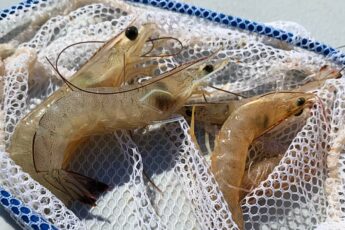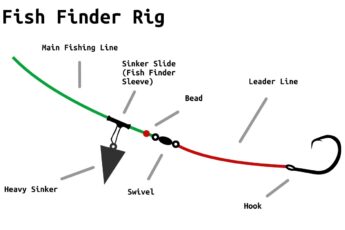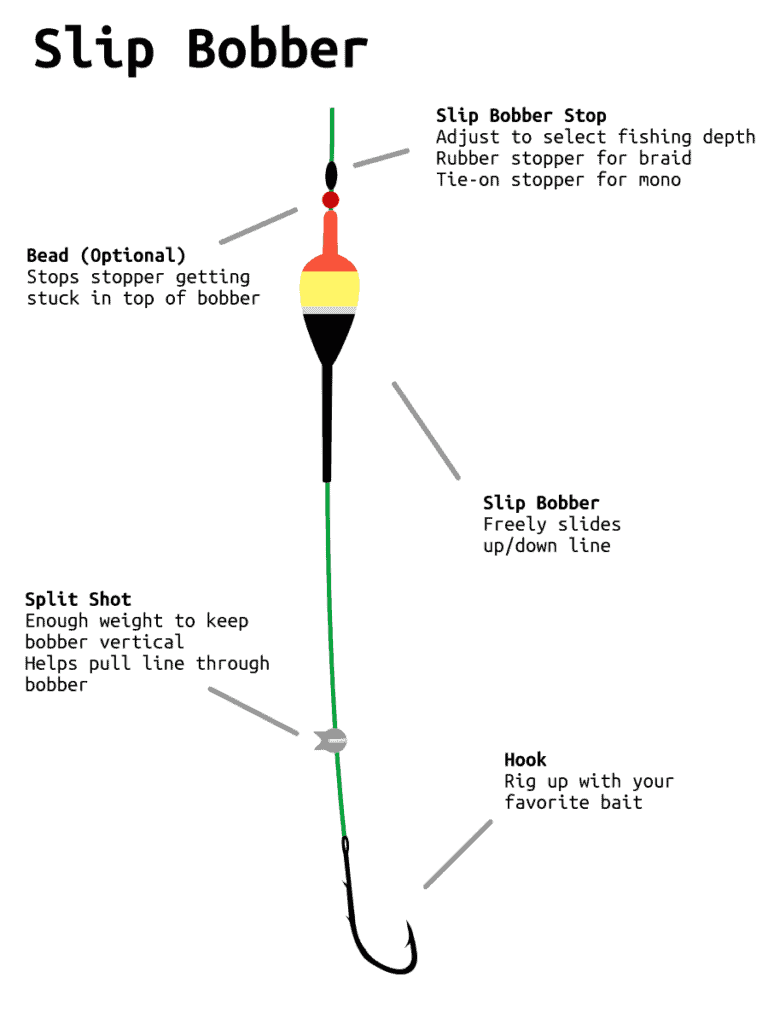
Slip bobber rigs are a key tool in the freshwater anglers arsenal. Everyone likes catching a mess of panfish for their Friday night fish fry. In this article I explain one of the most effective panfish catching setups – the slip bobber.
If your live bait terminal tackle, like a jig or carolina rig, is snagging bottom, whip out the slip bobber to allow you to fish at the perfect water depth. Read on to learn the slip bobber setup, why it is effective, and be catching limits of bluegill, perch, crappie, or walleye in no time.
*Disclosure: I only recommend products I would use myself and all opinions expressed here are my own. This post may contain affiliate links that at no additional cost to you, I may earn a small commission.
What Fish Can You Catch With a Slip Bobber Rig?
Slip bobbers are generally used to target panfish. Panfish is a term anglers use to describe good ‘eater’ fish where a legal keeper size fish will cook in a normal frying pan. While definitions can vary fisherman to fisherman, the below species are commonly referred to as panfish:
- Bluegill
- Sunfish Species
- Rock Bass
- Pumpkinseeds
- Perch
- Crappie
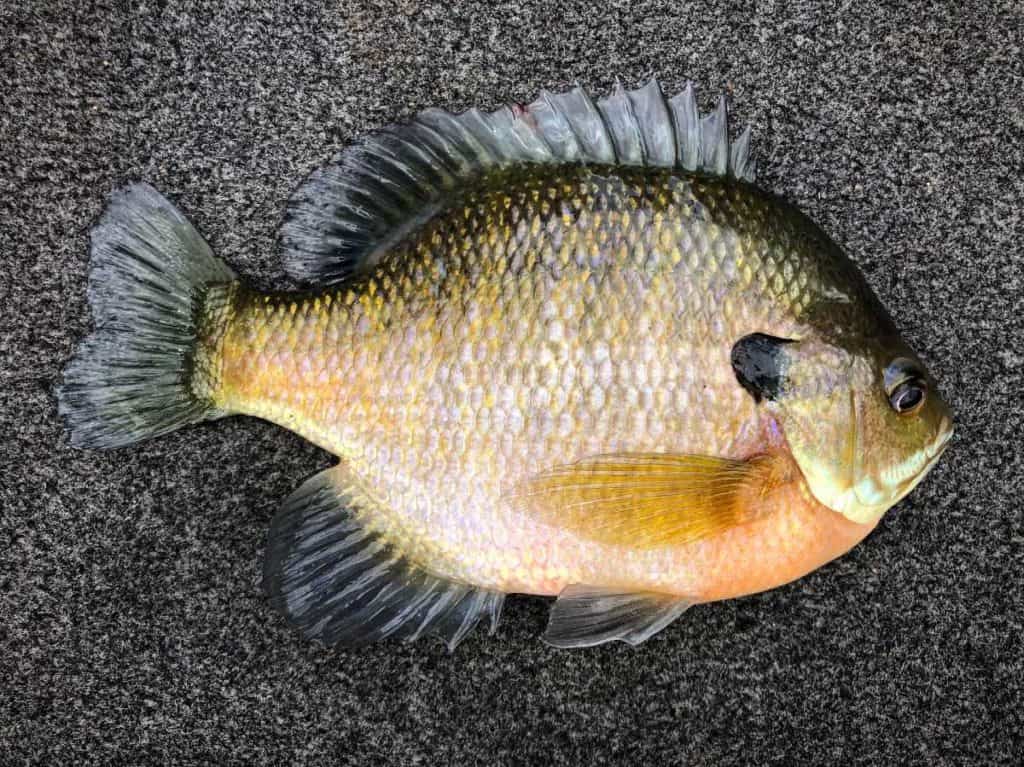
I’m going to honorary mention the illustrious walleye. Slip bobber rigs are also highly effective for catching walleye. Check out our article on best walleye rods and our article on the best ultralight rods to have the right rod for the job.
Panfish associate with underwater structures like rock piles, weed edges, docks, stumps, bridges and cribs. The structure offers them safety from predators. Fish for panfish around structure.
Pro tip: 90% of fish are in 10% of the water!
What is a Slip Bobber Rig and Why is it so Effective?
A slip bobber is a bobber rig where the depth is easily and completely adjustable. Want to fish a weed edge in 3’ of water? No problem. Rock pile in 14 feet of water? Have at it.

The bobber slides freely on your line until it hits a stopper knot. This knot gets adjusted to set your target depth.
A slip bobber is so effective because you can consistently get your bait right around the structure that panfish hold to. Since you’re not fishing in contact with the bottom you will snag less frequently.
In short – get consistently in the strike zone with great bait presentation!
How to Rig a Slip Bobber Rig
To rig a slip bobber you need:
- Small bait hooks (panfish generally have small mouths – size No 6 to 10 hooks work well)
- Split shot to bring your bait to the strike zone
- Slip bobber
- Optional Bead can stop the stopper knot getting caught in the top of the bobber
- Stopper Knot
- Knot style stoppers work well for monofilament fishing line but can slip too much on braid
- Rubber style holds better on braided line
To tie a slip bobber rig:
- Slide your stopper knot onto your line. Tighten the stopper knot and clip the tag ends off
- Slide the bead and bobber on
- Tie your hook with either a palomar knot or improved clinch knot
- Add your split shot roughly 4 inches above your hook
- Adjust your stopper to the desired fishing depth
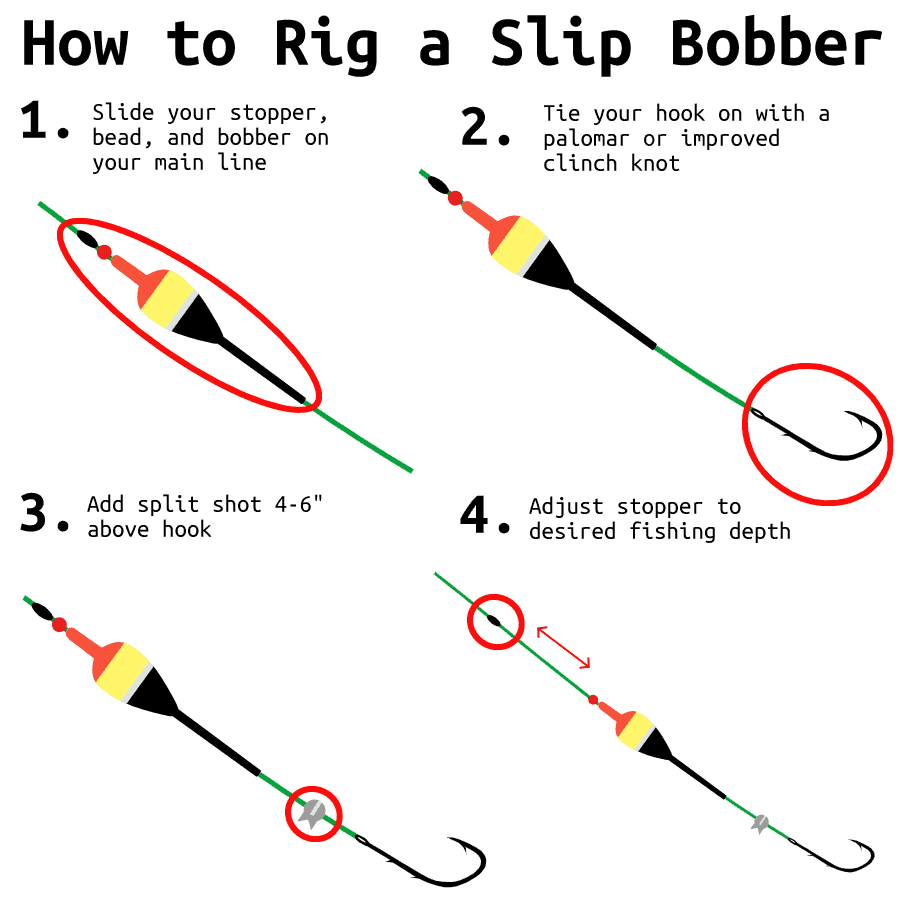
A variation of the slip bobber rig uses weighted slip bobbers. Instead of adding a split shot to the rig, a weighted slip bobber has a built in weight. Putting the weight on the bobber instead of near the bait can improve how naturally the bait floats in the water. One major downside is that in deeper conditions, the bait alone may not be heavy enough to properly pull line through the weighted slip bobber to get to the target depth.
How to Adjust a Slip Bobber Stopper
Once rigged up the only thing you need to do is set your depth.
Best practices to set depth properly:
- Move your stopper knot to fish ‘deeper’ until your bait sits on bottom and your bobber sits on its side. You’ve found bottom.
- Adjust your stopper knot ‘shallower’ by just enough to get your bait 6 inches off the bottom
Try to get your bait 6 inches off bottom and as close to structure as possible. If the bobber is sitting on its side, your bait is on bottom and you need to adjust your knot!
Pro Tip: Don’t just set your depth and forget it! Bottom depth varies. Adjust your depth to stay within 6 inches of bottom as you cast around until you narrow into a ‘hot spot’ on a piece of structure and start catching fish.
What Type of Bait to Use With a Slip Bobber Rig?
Live bait works best for panfish. Ideal baits include:
- Worms / Nightcrawlers
- Leeches
- Minnows
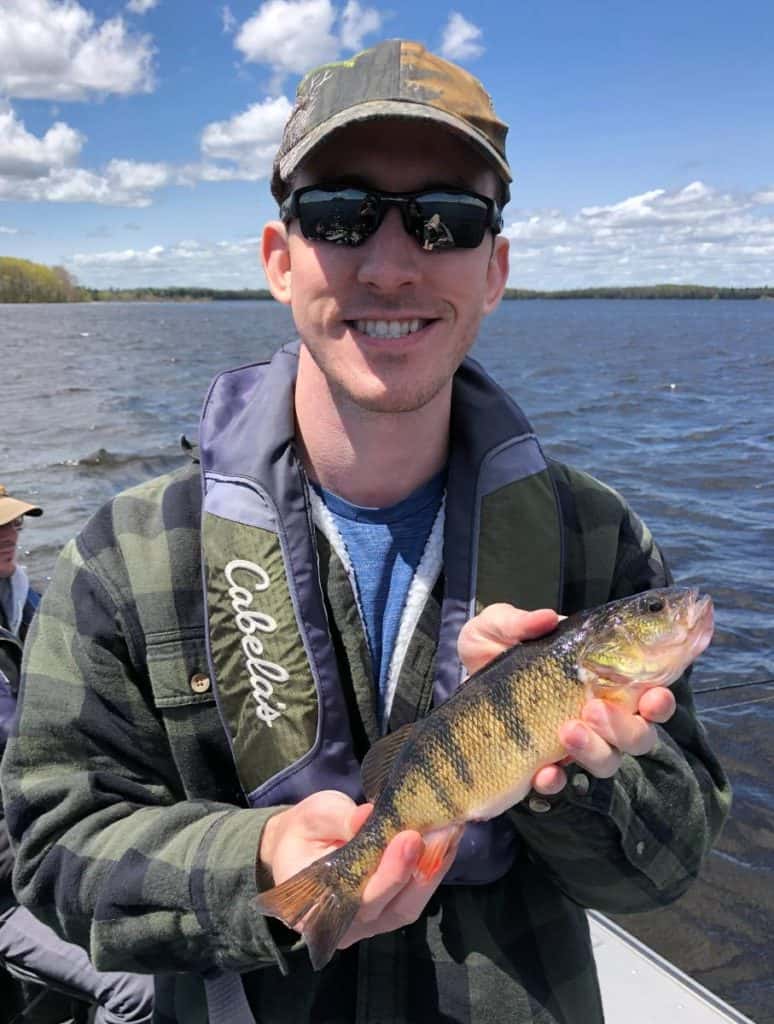
I have personally caught hundreds of perch, walleye, rock bass, and bluegills on primarily worms and leeches. We also pick up smallmouth bass and largemouth bass depending on the body of water.
Crappie prefer minnows over worms and leeches. Walleye can be finicky depending on the day. If just trying to catch fish you can’t go wrong starting with nightcrawlers.
Why use a Slip Bobber Rig?
Simply put, it’s one of the most effective ways to catch panfish (and walleyes!) with live bait. It is versatile for multiple water depths, avoids most snags, and gives ideal bait presentation. Make sure to have your fillet knife ready to fillet up your fresh catch!
Slip Bobber Rig Frequently Asked Questions
What is the purpose of a slip bobber?
A slip bobber allows anglers to fish bait below a floating rig where the fishing depth is easily adjustable. The slip bobber will slide all the way to the bait for easy casting, and will slide up the line until it hits the bobber stop at the target bait depth.
How deep can you set a slip bobber?
A slip bobber is most often used to fish at maximum depths between 20 and 30 feet but they can be used in depths of 50 feet or even deeper. Most fish caught with slip bobbers are between 4 to 20 feet deep. At depths of 10 feet or more, think about switching to some kind of bottom fishing rig like a jig.
How do you cast with a slip bobber?
Because slip bobbers slide down close to your bait when reeled in, they are relatively easy to cast compared to fixed bobber rigs. Reel your bait in until you have roughly three feet of line between your hook and your rod top. Casting with a slip bobber should be a gentle sweeping cast trying to land your rig as close to your target fishing structure as possible.
Do you need a bead for a slip bobber?
Beads are recommended between the stop knot and the slip bobber. The bead will protect your knot, stop the knot getting stuck in the top of the slip bobber, and also stop the knot potentially sliding through the slip bobber.
How far should the bobber be from the weight?
The split shot sinker weight should be 4 to 8 inches from the hook. You want to avoid the situation where your split shot is just barely off bottom and your bait is sitting on bottom. Keeping the split shot close to your hook, but not too close to scare the fish, helps avoid this issue. Ideally your bait should be dangling a few inches off bottom.
Slip bobber vs fixed bobber
Fixed bobbers do not slide up and down the fishing line like slip bobbers. Fixed bobbers are nearly impossible to fish in water depths deeper than around four feet because the set depth with the fixed bobber means the angler needs to try and cast as much line as their bobber is set at. Imagine trying to cast twenty feet of line between a fixed bobber and the bait below it. Slip bobbers are a more versatile option than fixed bobbers in most scenarios.
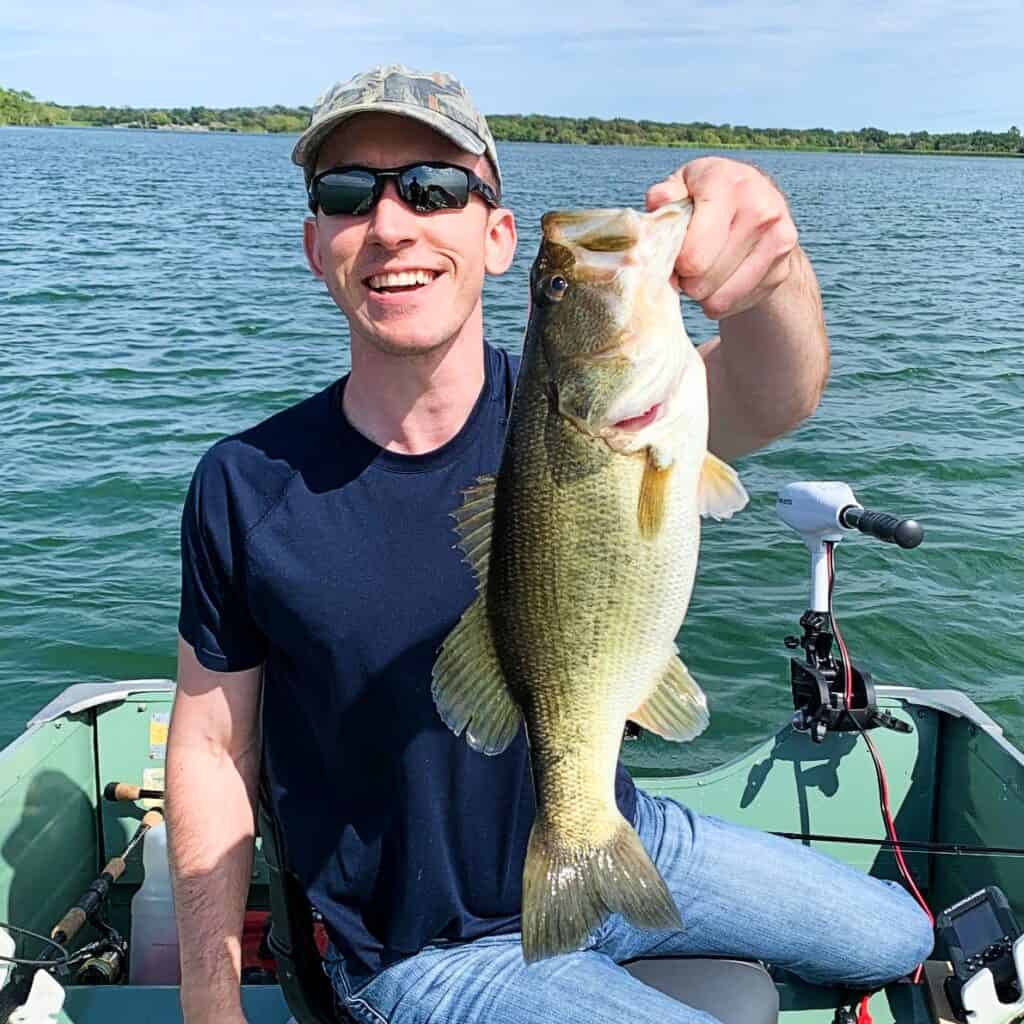
Written By: Andrew Juran
Andrew is a seasoned angler with over 25 years of experience fishing across the United States. He has caught hundreds of fish using various techniques and mentored many in the art of fishing. An advocate for sustainable fishing, Andrew is an active member of the Coastal Conservation Association, an organization committed to marine conservation.
For frequent fishing tips, behind-the-scenes looks, and real-time catches, connect with Andrew on Instagram




